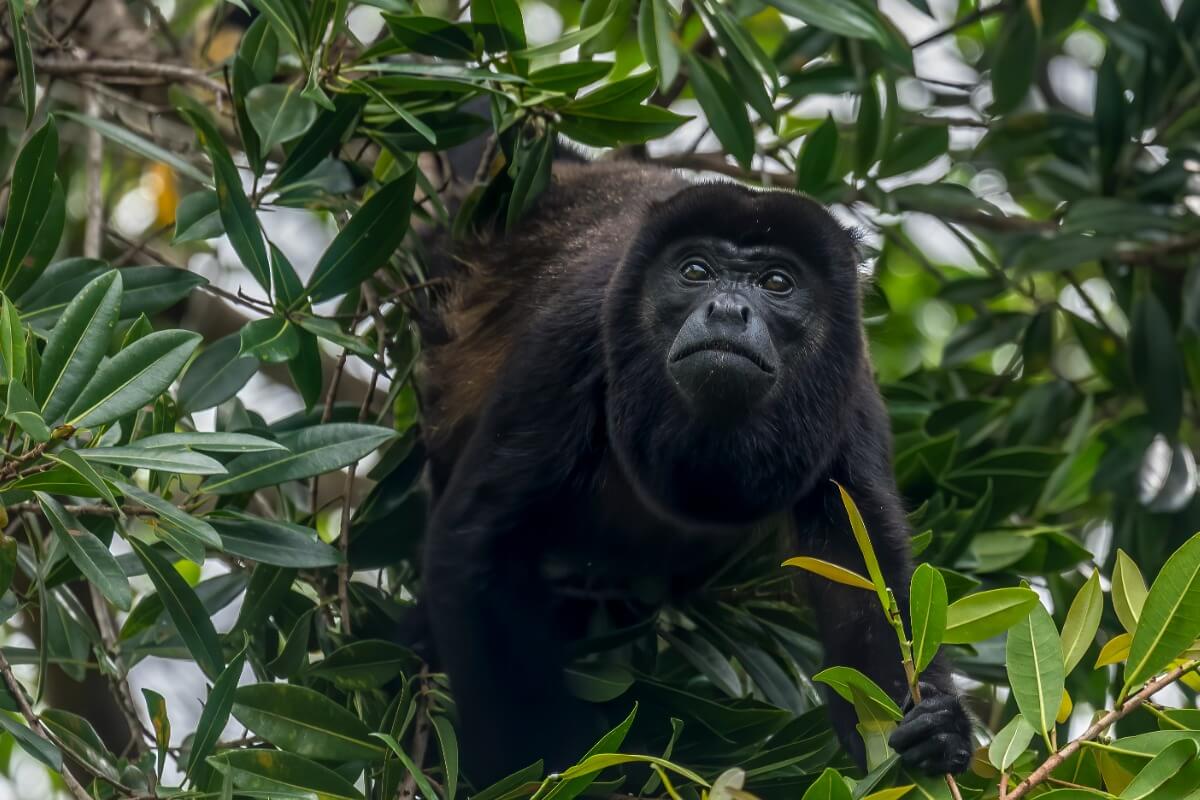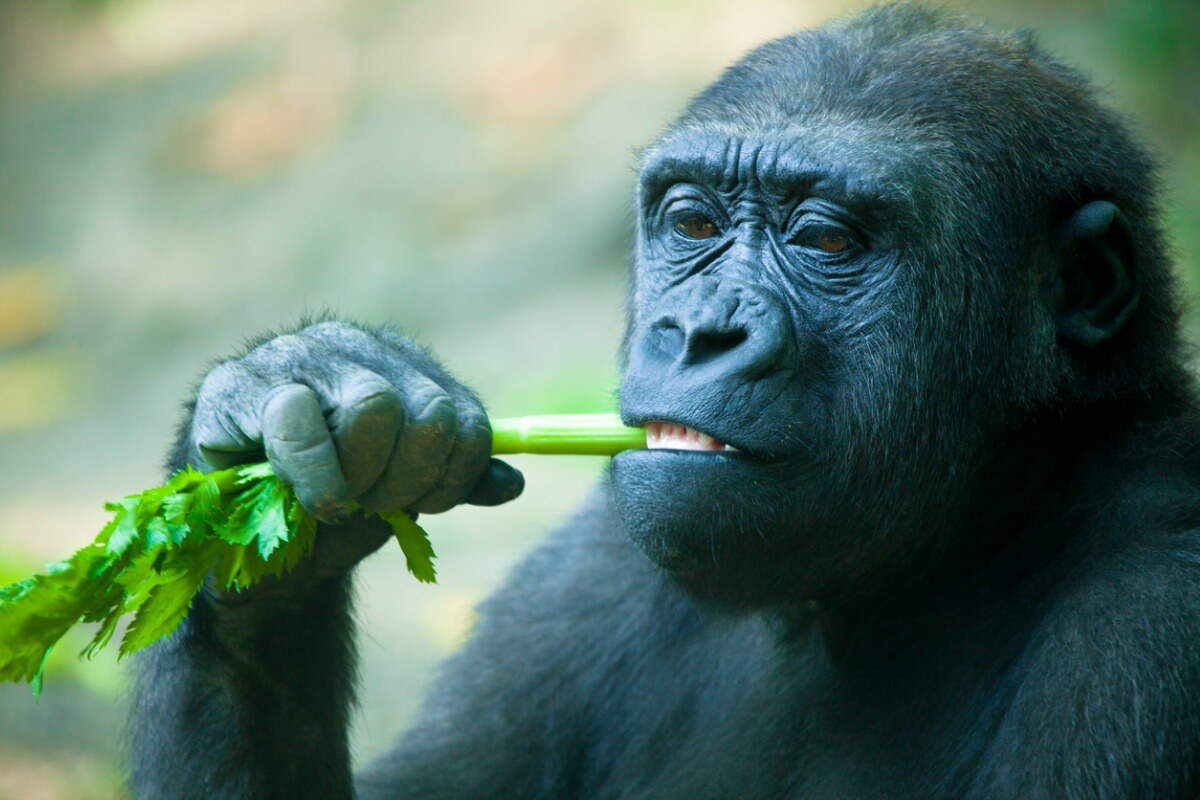10 Curiosities About Primates


Reviewed and approved by the biologist Samuel Sanchez
Primates are eutherian mammals full of surprises. One of the curiosities about primates is that experts believe that they arose approximately 55 million years ago from small land mammals, and then adapted to life in the trees of tropical forests.
These animals range in size from Berthe’s mouse lemur (which weighs about 30 grams – little more than an ounce) to the eastern gorilla (which weighs more than 200 kilograms – 440 pounds). If you’d like to marvel at their peculiarities, here are 10 other curiosities about primates.
1. Curiosities about primates: the human link
The biological order of these animals is divided into the following taxonomic classifications, according to the New England Primate Conservancy:
- Great apes: bonobos, chimpanzees, gorillas, humans, and orangutans.
- Small apes: gibbons.
- Monkeys: baboons, capuchin monkeys, howler monkeys, langurs, macaques, mandrills, mangabeys, marmosets, night monkeys, snub-nosed monkeys, spider monkeys, squirrel monkeys, woolly monkeys, among others.
- Prosimians: This is the oldest and most primitive primate order. It includes galagos, lemurs, angwantibos and tarsiers, among others.
Monkeys, lemurs, and apes are cousins of humans and we have all evolved from a common ancestor over the last 60 million years – so says the American Museum of Natural History. Because these individuals are related, they’re genetically similar to humans.
Some sources claim that human DNA is 96% identical to the DNA of the most distant primate relatives and almost 99% identical to that of the closest relatives, chimpanzees and bonobos. However, other interesting research concludes that it’s more in the range of 85%.

2. Primates live in Africa, Asia and Latin America
With the exception of humans, who live all over the world, most primates reside in tropical or subtropical regions. These animals live in various parts of Africa, Asia, and Latin America.
Great apes inhabit Africa and Asia, small apes live only in Asia, monkeys are naturally distributed in Africa, Asia, and Latin America, and prosimians live in Africa and Asia. There are also some introduced populations living in Gibraltar, the Caribbean islands, and parts of the United States, but these aren’t their natural habitats.
3. Most primates are in danger of extinction
There are 704 species and subspecies of primates, but 69% of them are threatened and endangered. However, new species of these animals continue to be discovered. More than 25 species were described in the 2000s, 36 in the 2010s and 3 so far in the 2020s.
The most common threats to these individuals are deforestation, forest fragmentation, and hunting for medicinal purposes, pets and food. Of these threats, the one that most threatens primates is large-scale logging of tropical forests.
4. Curiosities about primates: a long life expectancy
These mammals normally have large (relative to their body size) and highly developed brains. In addition, primates develop more slowly than other mammals of similar size, so they reach maturity later, but have a longer life expectancy. A gorilla lives on average 35 to 40 years.
5. Primates are among the most social animals
These individuals are among the most social animals, as they form pairs or family groups. Primates have at least 4 types of social systems, something very atypical in nature.
Close interactions between humans and primate groups can create opportunities for the transmission of zoonotic diseases, especially viral pathologies such as herpes, measles, Ebola, rabies and hepatitis. It is, therefore, necessary to limit contact with them.
6. Anthropoids also communicate by facial expressions
Lemurs, lorises, tarsiers and New World monkeys rely on olfactory signals to carry out many aspects of social and reproductive behaviour. These mammals use specialized glands to mark territory with pheromones to communicate.
Primates also use vocalizations, gestures, and facial expressions to convey a psychological state. Facial musculature is highly developed in these individuals, particularly in monkeys and apes, which allows for complex facial communication.
Like humans, chimpanzees are able to distinguish the faces of familiar and unfamiliar individuals. Hand and arm gestures are also important forms of communication for great apes and a single body movement can have multiple functions.
7. These individuals have very advanced cognitive abilities
Some of the primates have the ability to make tools and use them to acquire food and for social displays. They often perform tasks that require cooperation, influence, and rank, so they’re aware of social status. They can also be manipulative and deceive their peers.
Apes are able to recognize relatives and conspecifics and can learn to use symbols and understand aspects of human language. This includes some relational syntax, number concepts, and simple number sequences.
8. Most primates are nocturnal
Pottos (Perodicticus potto) and most other primates are most active at night. Although the eyes of many of these animals are specially adapted for night vision, some rely more on smell than sight to find food and communicate with each other.
9. Not all of these animals live in trees
Except for apes, all primates have tails. Depending on the species, adults may live alone, in pairs, or in groups of hundreds of individuals. Some primates, including gorillas and baboons, are more terrestrial than arboreal, but all species have adaptations for climbing trees.
10. Some primates can see a full spectrum of colors
Most mammals, including pottos and some others, are color blind and can’t distinguish the color red. However, many primates perceive a full spectrum of colors.
Color vision may have developed in primates because it helped them distinguish ripe red or orange fruits in contrast to the green forest background. Color vision also often helps some species of leaf-eating monkeys choose the most nutritious green leaves.
Many primates are nocturnal, so it isn’t surprising that several of them have never developed the ability to see red. Reddish colors are very difficult to see at night (even with full color vision).
The fight for protection
Only humans are recognized as persons and protected by the United Nations Universal Declaration of Human Rights. The legal status of primates is the subject of much debate, as there are organizations constantly campaigning to grant these mammals at least some sort of similar legal rights to the ones we have.
In June 2008, Spain became the first country in the world to recognize the rights of some primates. This happened when its parliament’s all-party environmental committee urged the country to comply with recommendations based on the fact that chimpanzees, bonobos, orangutans, and gorillas aren’t valid experimental tools.
Many primate species are kept in captivity by humans and it’s estimated that around 15,000 of these animals live as exotic pets in the United States. Although the importation of them was banned in the United States in 1975, smuggling continues to occur along the Mexican border. There’s still a long way to go.

Many of these animals have been used as models in laboratories, on space missions, as assistants for disabled humans, and as carnival clowns, among other functions that they weren’t designed for. Primates exist to give life to the forests and the ecosystems, because that’s where they belong – and not to serve as a tool for human culture.
All cited sources were thoroughly reviewed by our team to ensure their quality, reliability, currency, and validity. The bibliography of this article was considered reliable and of academic or scientific accuracy.
- American Museum of Natural History. (s. f.). What Do Primates Have in Common? Humans & Our Cousins | AMNH. Recuperado 13 de octubre de 2021, de https://www.amnh.org/exhibitions/permanent/human-origins/understanding-our-past/living-primates
- New England Primate Conservancy. (s. f.). Primate Facts. Recuperado 13 de octubre de 2021, de https://www.neprimateconservancy.org/primate-facts.html
- Wikipedia contributors. (2021, 8 octubre). Primate. Wikipedia. https://en.wikipedia.org/wiki/Primate#Classification_of_living_primates
This text is provided for informational purposes only and does not replace consultation with a professional. If in doubt, consult your specialist.